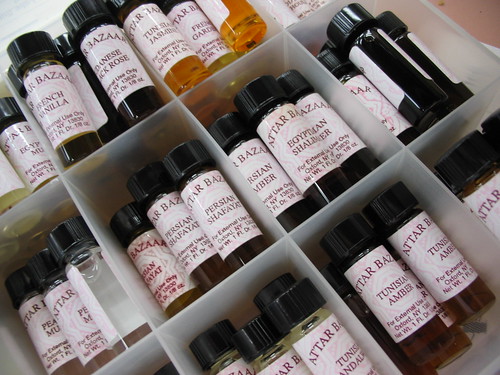 Wikipedia | The word 'Attar', 'ittar' or 'othr' is basically an Arabic word which means 'scent'; this in turn is believed to have been derived from the Sanskrit word Sugandha, meaning 'aromatic'. The earliest distillation of Attar was mentioned in the Ayurvedic text Charaka Samhita. The Harshacharita, written in 7th century A.D. in Northern India mentions use of fragrant agarwood oil.
Wikipedia | The word 'Attar', 'ittar' or 'othr' is basically an Arabic word which means 'scent'; this in turn is believed to have been derived from the Sanskrit word Sugandha, meaning 'aromatic'. The earliest distillation of Attar was mentioned in the Ayurvedic text Charaka Samhita. The Harshacharita, written in 7th century A.D. in Northern India mentions use of fragrant agarwood oil.The story of Indian perfumes is as old as the civilization itself. Archaeological evidence shows the earliest inhabitants of the Indian subcontinent held plants in great reverence. With the passage of time, scented oils were extracted by pressing, pulverizing or distilling aromatic vegetal and animal produce. Such processes led to the development of the art of alchemy, the earliest indications of which are available from the perfume jars and terracotta containers of the Indus Valley civilization. That the art has survived for centuries speaks volumes for the Indian perfumes.
Integrated into India's daily life, scented plants are used to celebrate every aspect of Indian culture, from the ritual to the culinary, from the celibate to the erotic. Vedas mentioned a combination of numerous herbs, twigs, barks and flowers as offering to Gods in yagnas.
Archaeological excavations have revealed round copper stills, used for making attars, that are at least five-thousand years old. These stills are called degs. Following the seasons of the flowers, traditional attar-makers, with their degs, traveled all over India to make their attars on-the-spot. Even now, rural areas often lack good roads to quickly transport the harvested flowers, and a few traditional attar-makers still travel with their degs to be close to the harvest. Their equipment has changed little, if at all, in the last five thousand years.
In ancient India, an Attar was prepared by placing precious flowers and sacred plants into a water or vegetable oil. Slowly the plants and flowers would infuse the water/oil with their delicate fragrance. The plant and flower material would then be removed and a symphony of their aromatic beauty would be held in the Attar. These Attars were then worn as a sacred perfume or to anoint.
In Ain-e-Akbari, Abul Fazal, has mentioned that Akbar used ittar daily and burnt incense sticks in gold and silver censers. A princess’s toilette was incomplete without incense and attar. A very popular ittar with the Mughal princes was ood, prepared in Assam.
Ittar is an indigenous product of Kannauj Uttar Pradesh India. According to Mr. Afsar Ali Khan of Nizam Attars Hyderabad India. There is a legend on how the first ittars were made. The forest dwelling Hindu Sadhus, used certain perfumed jungle herbs and roots in their bonfires during the winters. The shepherds who grazed their sheep in that region, found the perfume lingering in the burnt wood, long after the Sadhus left the place. Word spread about this incident and some enterprising people, searched and found the fragrant herbs and roots. Then the experiments on ittar began and one of the first ittars to be made was Rose and Hina.


0 comments:
Post a Comment